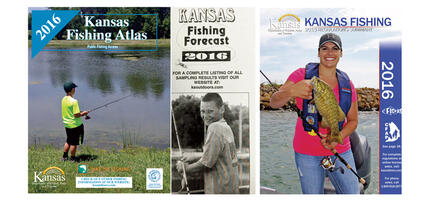Anglers’ Secret Weapons

PRATT – Every angler is searching for that secret lure that will catch more fish than all the others. However, if they exist, they’re expensive and don’t come with a guarantee. Fortunately, there are a few tools designed to help you catch more fish and they are free. The 2016 Kansas Fishing Regulations Summary, 2016 Fishing Atlas, and the 2016 Fishing Forecast are available online and wherever licenses are sold.
To catch fish, you have to be in the right spot with the right equipment at the right time. And to ensure your fishing days are enjoyable, you need to know the regulations. These three publications produced by the Kansas Department of Wildlife, Parks and Tourism will help you find the right spot and know the regulations.
The 2016 Kansas Fishing Regulations Summary includes critical information about license requirements and fees, creel and length limits, special fishing programs, and color illustrations for fish identification. The pamphlet has a complete listing of public waters in the state, including locations and any special regulation. Special fishing programs, such as the trout program and urban fishing program, are highlighted with locations and stocking schedules.
The 2016 Fishing Atlas is an 80-page color publication with maps showing all public fishing areas, including state and federal waters and the Fishing Impoundments and Stream Habitats program (F.I.S.H.) waters. The F.I.S.H. program leases private ponds and stream and river access and opens them up to public fishing. In recent years, the program has opened more than 1,900 acres of private ponds and more than 70 miles of streams to anglers. Most areas are open from March 1-Oct. 31, but some are open to angling year-round. Lease dates, special regulations, and boating restrictions are also designated for each leased tract in the atlas.
The final piece of the angler’s arsenal is the 2016 Fishing Forecast, which is available as a printed brochure, can be downloaded from www.ksoutdoors.com and is included in the March/April issue of Kansas Wildlife & Parks magazine. The forecast summarizes data collected by fisheries biologists throughout the year to help anglers find the best fishing spots statewide. The forecast includes Density, Preferred, and Lunker ratings for 17 species of sport fish in more than 200 state fishing lakes, community lakes and reservoirs. Anglers can use the forecast to find a lake that has a good population of the species they like to catch. For example, if you like to catch white bass, you’ll see that Pomona Reservoir has the No. 1 Density Rating, which refers to the number of white bass that were 9 inches long or longer the biologists caught per unit of sampling effort. Pomona also has the highest Preferred Rating of 11.58, which means that of the fish sampled almost half were longer than 12 inches. However, if you’re interested in large white bass, you might want to try Cedar Bluff Reservoir, which had the No. 1 Lunker Rating, which refers to white bass in the samples longer than 15 inches. Lengths for the various ratings are different for each species, and there are also categories for the biggest fish caught during sampling and the biologist’s ranking. Ratings are separated among reservoirs, lakes and ponds, so anglers can also select the size of the water they prefer to fish.
These three tools, along with the Weekly Fishing Reports at www.ksoutdoors.com, will help you catch more fish this season, guaranteed. Don’t get caught on the water without them.
-30-







